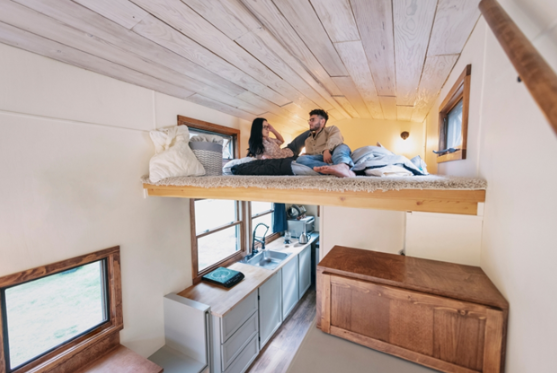Are Tiny Houses an Affordable Housing Solution? It Depends on Who You Ask

Are Tiny Houses an Affordable Housing Solution? It Depends on Who You Ask
by Jerome Ryans, President & CEO, Tampa Housing Authority
The "tiny home" has existed in the American housing landscape since at least the 1980s, although cottages, cabins, trailers, and small bungalows have existed for much longer without the umbrella term.
The modern concept harkens a movement to downsize, simplify, and live in a more minimalistic way. With the emergence of more tiny homes comes a much-debated question: are tiny houses an affordable housing solution?
The answer, not surprisingly, is both "Yes" and "No." It's probably best summed up as, "It depends on the context." In this article, we will take a tour of the pros and cons of tiny houses to help elucidate their place in affordable housing strategies.
Pros
Quick Builds
Since tiny homes require fewer materials overall, builders can construct them more quickly and at a generally lower cost than an average-sized home. If the financing, location, and supply chain line up well, a tiny house can be completed within 30-45 days of ordering it - while the average time to build a new, single-dwelling home is seven months. In fact, it's not uncommon for new builds to take a year or longer.
This is why some cities have used tiny home communities so effectively to mobilize people from houselessness to housing stability. While the structures may be very minimal - one-room with a basic kitchen and bathroom - they allow people to store their belongings, sleep in safety, and have a permanent address.
When quality housing can be produced quickly and cheaply, residents are more easily able to put down roots, find employment, and develop a sense of community. While no single solution will ever work as a way to provide affordable housing for all, you can see how tiny houses could comprise a major housing solution for unhoused people.
Accessible Home Ownership
Tiny homes make home ownership more possible. The price tag for a tiny house typically falls way below most larger home prices, ranging from $16,000 for a 100-square foot cottage on wheels to $150,000 for a luxury, multi-room tiny home built on a foundation. You can find many suitable tiny houses with multiple sleeping spaces in the $40,000-$70,000 range.
While that amount of money may not sound "inexpensive," consider that the mortgage industry has moved to keep up with tiny home demand. Potential buyers can now acquire an RV or tiny-house-specific mortgage, meaning that they only need to be able to afford a down payment - likely below $10,000, sometimes $0 down - as well as the monthly payments for that tiny house.
For people who are financially sound enough to pay rent but may struggle to save up for a larger down payment, they can likely manage this financial responsibility - opening up new opportunities for home ownership to a wider population.
This also facilitates a tiered approach to ownership, building both equity and passive income. First, a person can buy their tiny home. Later, they can buy land. When a tiny homeowner becomes a landowner, they may want to build a larger house on the land and keep the tiny house as an accessory dwelling unit (ADU) for passive rental income. Keep in mind that this is possible if the tiny home is movable - and many are for just this reason!
More Housing Supply
We have yet to address the bottom-line of pro-tiny house arguments: when a community fits tiny houses into whatever spaces are available, overall housing supply increases. That can help increase affordable rent and mortgage options both in the wider market and through the lower-price pockets of specific tiny home offerings in an area.
Cons
Inefficient Usage of Land Space Compared to Denser Housing
While part of the tiny house dream is having your own little yard surrounding it, this also draws criticism. Proponents of denser housing argue that placing one or even a few tiny houses on an acre of land is a much less efficient use of that lot as compared to a dense, highly vertical, multi-family housing unit.
You can probably see how these housing structures appeal to quite different sensibilities. One simulates the "American Dream" house of a picket fence with a yard, just in micro conditions - while the other embraces a new, more urban vision of "American Dense Housing."
Some would also rebut that, if a single family home has a backyard, adding a tiny house increases density where it's possible, in a realistic way. Put another way, that homeowner is not going to add a condo tower next to their vegetable garden in the back.
Lack of Traditional Equity-Building
Since tiny homes don't include land ownership, they don't appreciate in the same way as other real estate. While the pros of movability and tiered ownership above still stand, some critics believe that the lack of equity in tiny houses does not make them worth the investment in the first place.
It is something to consider - if you have almost enough saved up for a down payment on a traditional house, it may be worth waiting a bit longer in order buy a house on land.
Tiny Homes Don't Address Conjunctive Affordable Housing Issues
Tiny homes do not ameliorate the issues of urban overcrowding, decreasing wage power, or effective public transit, which are part and parcel of the affordable housing/living conversation.
Since tiny homes would need to be in proximity to transit, jobs, and food to truly increase affordable housing supply, they need to be in more central locations. Unfortunately, it can prove a challenge to place them in urban centers. Why? The core competition in urban centers happens over available land - any available land at all. A smaller house will not solve that problem.
Mostly, tiny homes work well when they fit into existing structures. Sometimes this puts tiny house communities on the edge of town, far from amenities and jobs, which poses the same transportation challenges and costs as other housing projects. As with our evaluation of mixed-income housing, tiny house building needs to be accomplished with intentionality in order to truly change a community for the better.
One Wave in a Sea of Solutions
So, are tiny houses an affordable housing solution? Absolutely! They just aren't the solution.
It would behoove public housing agencies and lawmakers to stop looking for a panacea that likely doesn't exist. While a tiny home may not be a good fit for all situations, it is still a viable option for some people in certain situations. They can give families a much-needed home when the alternative is homelessness, and they can act as a stepping stone to homeownership and eventual land ownership for folks who are gradually building wealth.
In short, we need to view tiny homes as one of many tools in the affordable housing toolkit and focus on utilizing those tools effectively.
References
Home Guide. (2024). "How Much Does A Tiny House Cost?." Retrieved from [URL]: https://homeguide.com/costs/tiny-house-cost#:~:text=A%20tiny%20house%20costs%20%2430%2C000%20to%20%2470%2C000%20on,home%20is%20typically%20cheaper%20than%20a%20custom%20design.



